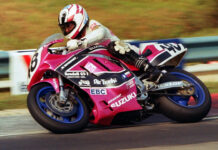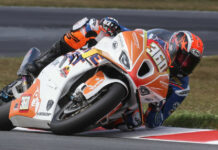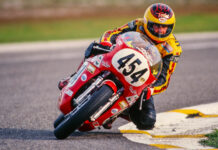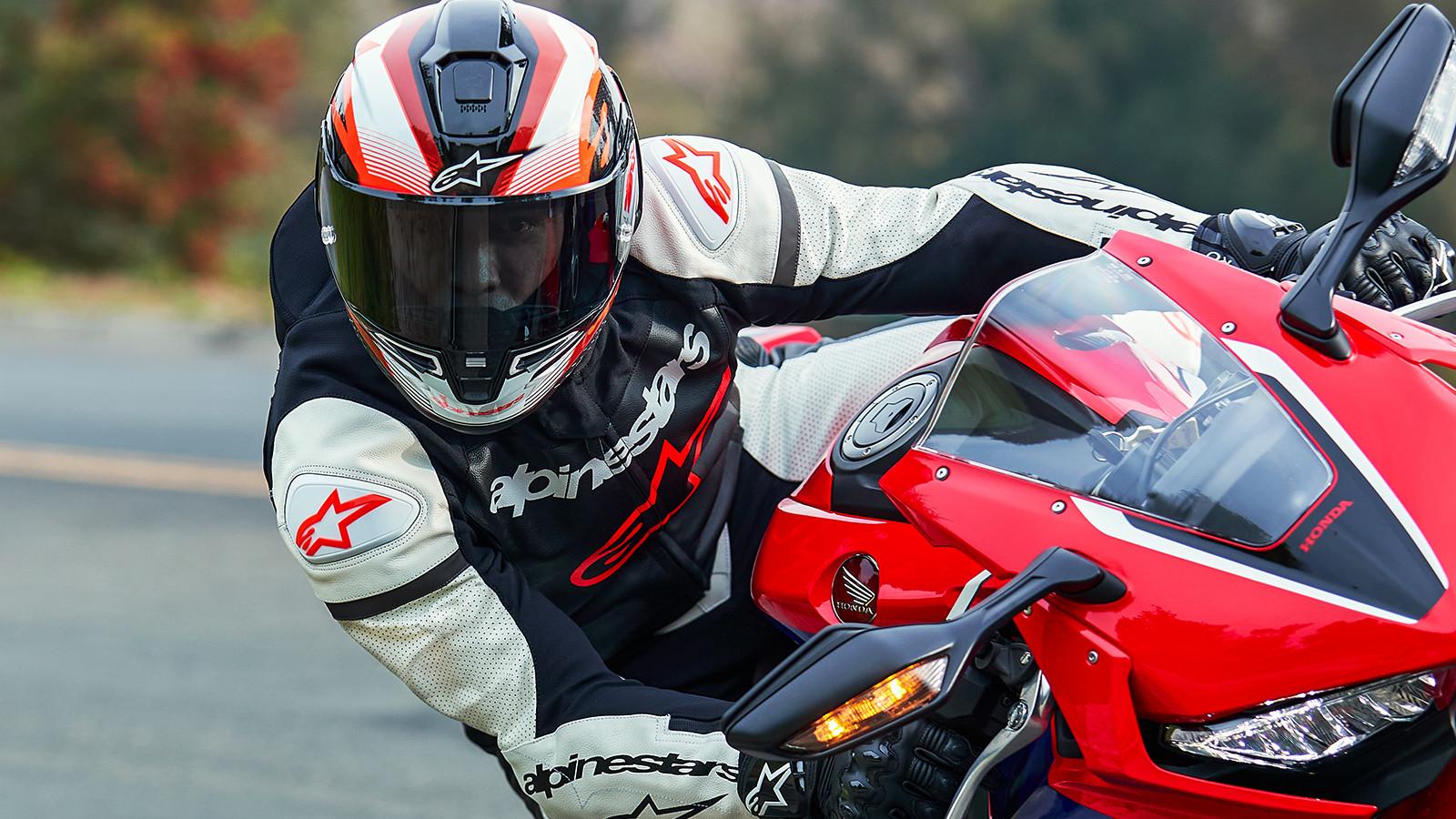ALPINESTARS REVEALS THE ALL-NEW SUPERTECH R10 ROAD RACING HELMET
Asolo, Italy and Los Angeles, CA – Alpinestars is pleased to present the all-new Supertech R10 Road Racing Helmets. The result of over 10 years of intensive study, development, and testing, the goal of the Supertech family of helmets is to create the most advanced, protective, and performance-enhancing helmets possible for racers and riders worldwide.
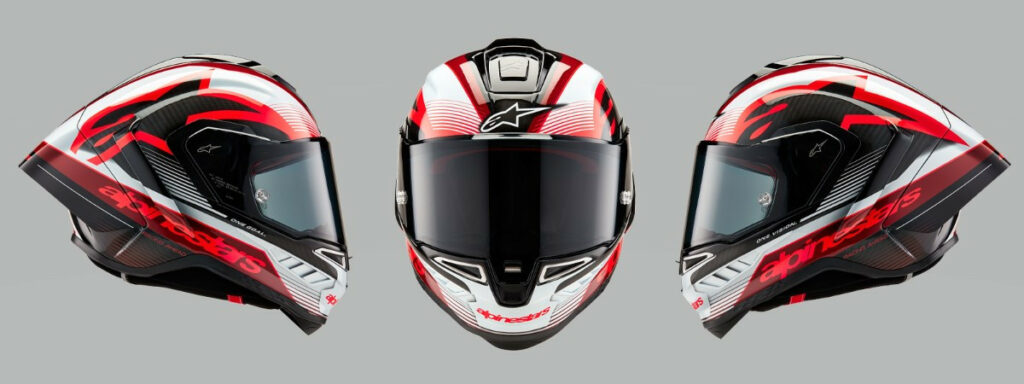
After years of research, development, and testing by Alpinestars’ Helmet Product Development Department including MotoGP legend Andrea Dovizioso, today sees Alpinestars launching the S-R10 Road Racing Helmet. With the S-R10, the focus of the design was to ensure the highest level of performance, particularly when it comes to protection and providing a new level of safety. Additionally, the S-R10 Helmet has been engineered to provide the perfect blend of excellent ventilation, unsurpassed comfort, and the lightest weight possible, without compromising on any other front. Another crucial element unique to the S-R10’s design and development is the helmet’s advanced aerodynamics, achieved through countless sessions in the wind tunnel focused on reducing drag and providing optimal aerodynamic stability. This benefits performance on track, and greatly improves comfort for long rides on the road.
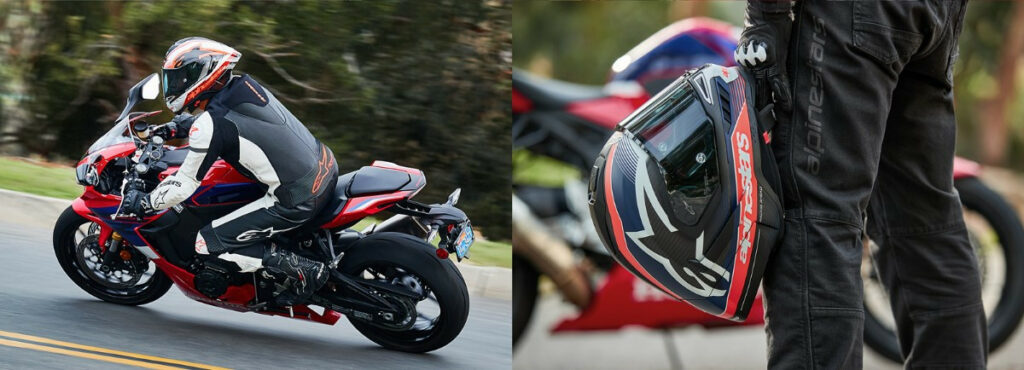
The Alpinestars Supertech R10 Helmet will be available in 6 sizes – XS through 2XL – and in both solid and graphic colorways. Solid colors will include: black carbon matte and glossy, white glossy, and matte black. In addition, Alpinestars is launching two graphics with two colorways each. The racing-inspired TEAM graphic, available in black carbon/red/white glossy, and black carbon/red fluo/dark blue matte, and the minimalistic and heritage ELEMENT graphic, available in black carbon/bright red/white glossy, and black carbon/silver/black glossy.
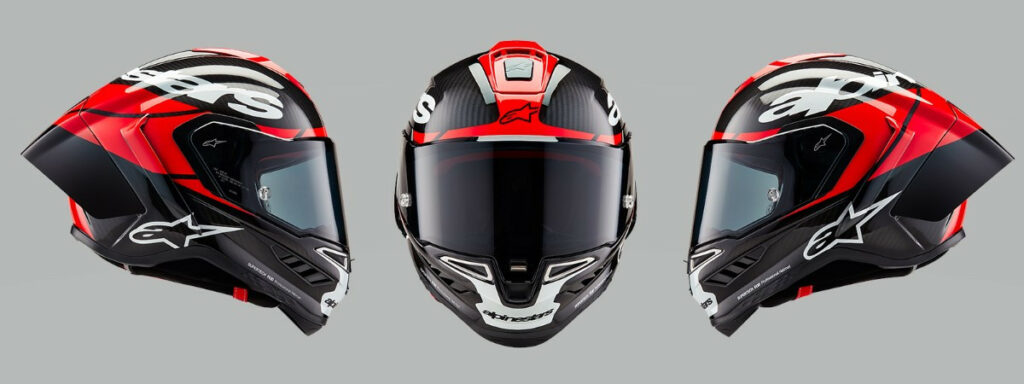
The S-R10 Helmets will be available for purchase at authorized Alpinestars dealers and distributors, with a limited number available on alpinestars.com starting at 6 pm CET / 9 am PST, on January 30th. The Supertech R10 helmet full-line is going to be available in the United States and Europe in March, with limited online availability and in select North American retailers starting today. The S-R10 will also be available in Asia, with a dedicated Asia fit in the second part of 2024. Stay tuned for more information about the Supertech R10 Road Racing Helmet and subscribe to our newsletter if you want to be among the first to own one.
All helmets include both clear and dark smoke visors, tear-offs set, Pinlock® lens, chin curtain, and wind and breath deflectors. Accessories for the Element and Team helmets can be stored comfortably in the paddock helmet bag provided with the S-R10.
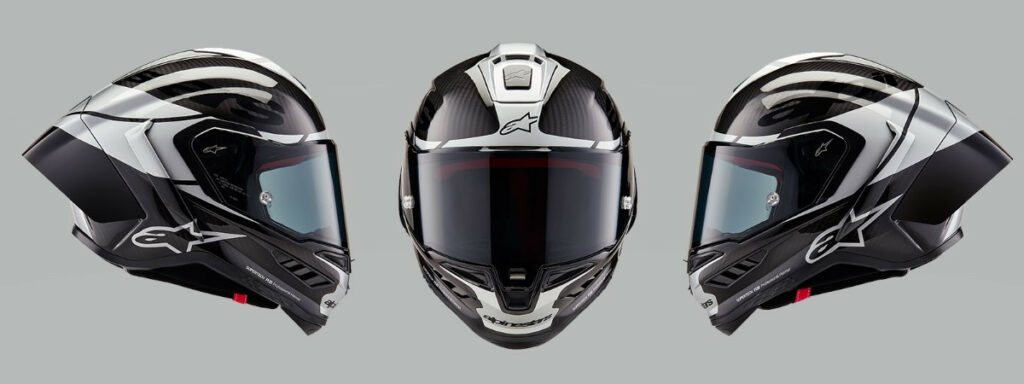
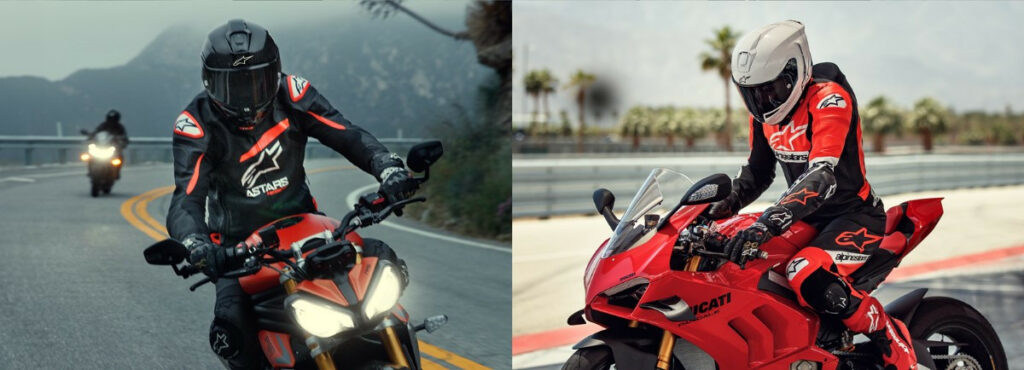
SUPERTECH R10 HELMET TECHNICAL FEATURES
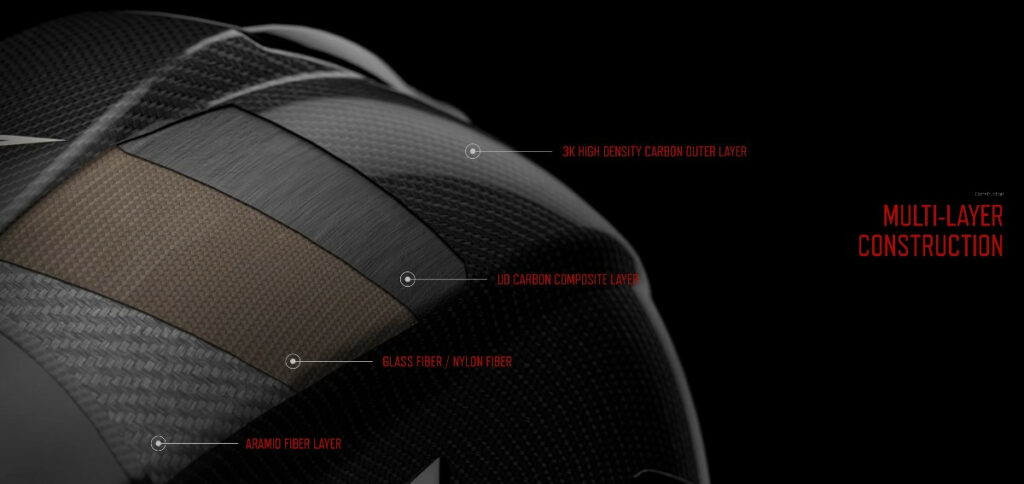
OUTER SHELL
CARBON SHELL CONSTRUCTION MULTI-LAYER COMPOSITE DISPERSES ENERGY IN IMPACTS
Homologated to ECE 22.06, DOT, and FIM standards, the Supertech R10’s shell construction utilizes a highly advanced molding technology with a multi-composite combination featuring a 3K high-density carbon outer layer, a uni-directional carbon composite layer, an aramid fiber layer, and a fiberglass layer.
The 3K high-density carbon outer layer provides excellent strength and efficiency of energy dissipation over the shell. The uni-directional (UD) carbon composite layer provides significantly greater radial strength around the shell, preventing compression, but allowing controlled deflection for reducing transmitted impact energy, while the aramid fiber plus fiberglass layers provide critical penetration protection.
This layered composite combination created by bonding everything together with an advanced epoxy resin already applied on the pre-preg fiber, perfectly controls the ideal proportion of resin versus fiber to maximize strength, mechanical performance, and lightweight. The combination of material layers provides improved energy management, as well as limited outer shell deflection, making the energy spread wider and better absorbed by the EPS liner.
The S-R10’s unique shell construction results in extremely effective impact protection. With a fully equipped in-house helmet testing facility within Alpinestars’ state-of-the-art Research and Development center, the company has carried out an exhaustive impact research program, where research and development efforts have shown the S-R10 helmet returning linear and oblique impact performance results which far exceed current ECE 22.06 helmet regulation standard limits. For direct linear impacts, which are impacts at a 90-degree angle between the helmet and an object, the S-R10 surpasses the standard by an average magnitude of 37%. And for rotational acceleration and oblique impact performance, where impact energy comes from an angle other than a linear 90-degree, or right-angle straight impact, the S-R10 exceeds the standard by 65%.
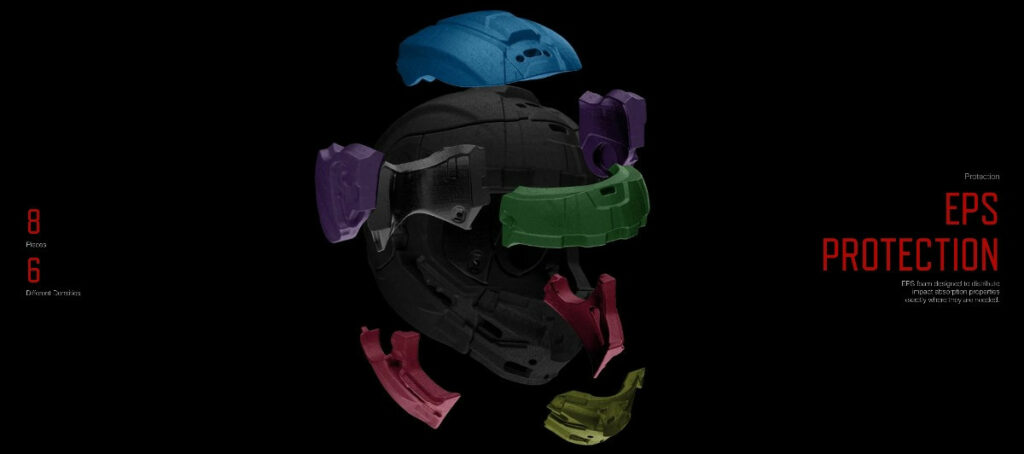
INNER SHELL
THE S-R10’S INNER SHELL IS MADE FROM EPS IN DIFFERENT DENSITIES
The S-R10 Helmet has four inner shells just like the outer shell, and is available in four anatomical sizes. The S-R10’s construction is optimized to ensure riders have the correct fit, which not only improves comfort and reduces overall weight but most importantly, improves the effectiveness of the helmet in an impact. Underneath the helmet’s outer shell is an eight-piece multi-density EPS liner, with six specific densities that are strategically positioned in different zones to ensure excellent energy absorption from impact forces dissipated over the outer shell, as well as a close and comfortable fit. The EPS liner, just like the outer shell, has its own unique dimension for each helmet size, further tailoring the helmet’s performance and fit when it comes to protection and comfort.
LINEAR AND OBLIQUE FORCE MANAGEMENT
The EPS inner surface is smooth, creating an optimized, low-friction area, for superior oblique impact management. When it comes to other types of helmet testing, the best helmets are those that provide protection against rotational, as well as oblique and linear impact forces.
To help fight and mitigate those rotational, oblique, and linear impact forces, Alpinestars has designed a low-friction surface on the inner surface of the EPS liner. The inner surface is polished to be incredibly smooth, and then specially coated to reduce friction even further, allowing the comfort liner to move against the EPS. The result is increased rotational and oblique and linear force management, allowing the rider’s head to move independently inside of the helmet, or vice-versa, which can significantly reduce the amount of force transmitted to the head, neck, brain, and spine from an oblique impact, while simultaneously reducing the possibility of a concussion. To recap, specific rotational impact protection is provided by the combination of the internal shape and the specific coating of the EPS liner, coupled with the specially developed surface in the comfort liner. This patented technology reduces rotational acceleration transmitted to the rider’s head.
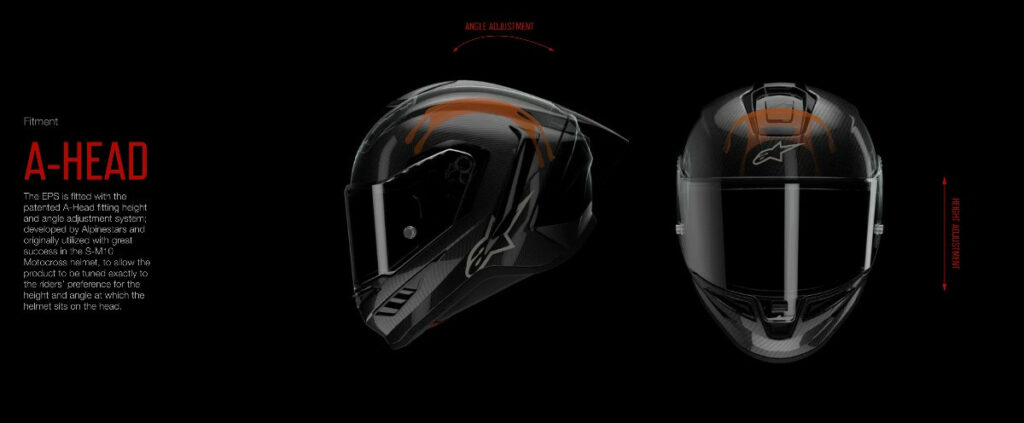
A-HEAD FITMENT SYSTEM AND CUSTOMIZED FIT
Adding to the personalization and custom, tailor-made fit of the S-R10, is the helmet’s unique and patented A-Head Fitment System. The A-Head System allows the helmet to be tuned exactly to the rider’s preference by having the ability to adjust both the height and angle at which the helmet sits on the head. The EPS is fitted with the A-Head Fitment System that allows for an ultra-specific setup that can be adapted to how deep the rider’s head sits in the helmet, as well as how far forward or backward the helmet is tilted.
To provide riders with the ability to further tailor the SR10’s fit to better suit a wide variety of different head shapes and sizes, Alpinestars is offering a variety of spare parts in a vast range of sizes giving motorcyclists the ability to change and swap out the cheek pads, crown pad, and top pad with a selection of both thinner and thicker options, to truly customize the helmet’s comfort for a perfect fit. With the S-R10’s various inner comfort liner options, plus the unique and patented A-Head Fitment System, there are virtually countless inner fitment configurations to meet the fit and performance needs of all riders.
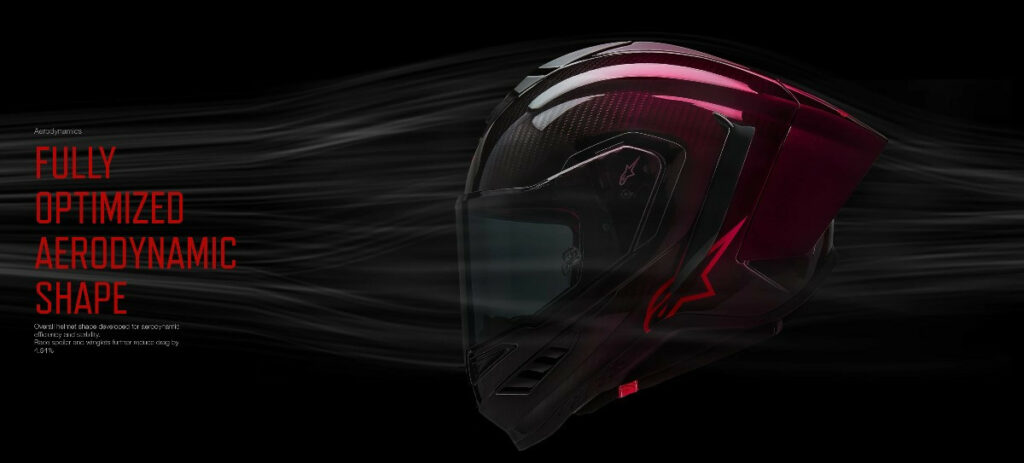
AERODYNAMICS
DEVELOPED WITH CFD SIMULATIONS, VALIDATED IN THE WIND TUNNEL AND ON TRACK, THE S-R10 HELMET IS OPTIMIZED FOR LOW DRAG PERFORMANCE AND MAXIMUM AERODYNAMIC STABILITY
Designed and developed for professional MotoGP athletes where going faster and being protected is the goal. By minimizing drag and ensuring optimal aerodynamic stability, air management outside and inside of the helmet, and a comfortable, customizable fit, the S-R10 Helmet ensures the overall experience in racing and sport riding is fit for champions.
The S-R10 has been developed in the full-scale wind tunnel since the beginning of its development. Aerodynamic targets for the coefficient of drag in different head positions, as well as stability at different angles were a primary goal in the helmet shape development, first extensively developed with Computational Fluid Dynamics (CFD), then validated in the full-scale wind tunnel, and finally on track. The result is a helmet that achieves the lowest level of drag, and the highest level of aerodynamic stability at high speed compared to any other race helmet that we have tested in the wind gallery. This has made the S-R10 already the helmet of choice by factory MotoGP teams for its top aerodynamic performance. Road riders will likely benefit from this too, with reduced strain on their necks at high speed and low levels of wind noise.
The S-R10 Helmet’s aerodynamic spoilers are fitted with an Alpinestars patented release system, with elastic joints that help the spoiler detach from the helmet shell if it is subjected to a significant impact, no matter what the angle, to reduce potential rotational energy.
The helmet also comes with lateral winglets to further support the S-R10’s stability and improve aerodynamic drag. In addition, the helmet visor has turbulators to improve aero-acoustic performance. As a result, compared to the aerodynamic performance of the helmet fitted with the standard road spoiler, the S-R10 itself is already the top-performing, aerodynamic helmet we have tested, and with the configuration of the race spoiler and the aero winglets together, Alpinestars Helmet Development team have achieved a reduction in drag for the helmet of an additional 4.54%.
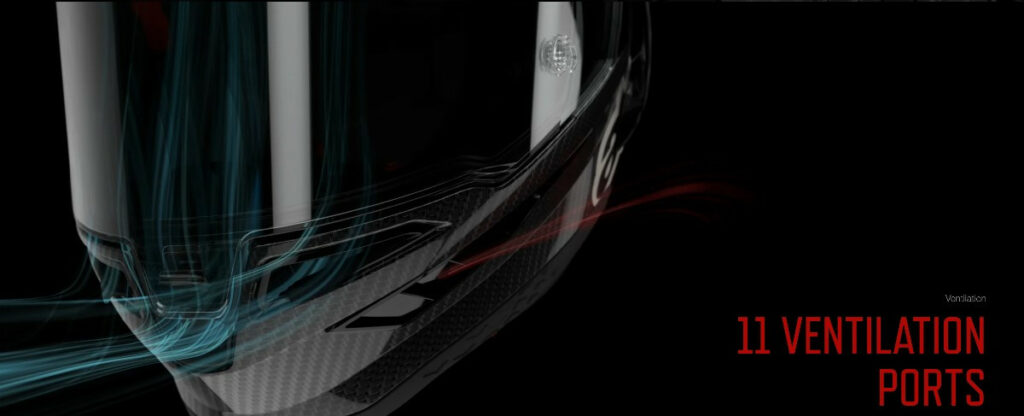
VENTILATION
THE SUPERTECH R10 HELMET CONTAINS ELEVEN VENTILATION POINTS
When it comes to ventilation and breathability, there are 11 ventilation ports, not including the eyeport, with 7 intakes including 3 in the chinguard and 4 on the top of the helmet, plus 4 exhausts, with 2 lateral ports on the chin bar, and 2 on the top rear of the helmet. These ventilation ports integrate directly with the helmet’s shell with a series of air ducts through the inner EPS liner. With the S-R10, airflow comes in through the ports, as well as actively circulates over and around the rider’s head through a series of channels, and then gets extracted out the back of the helmet.
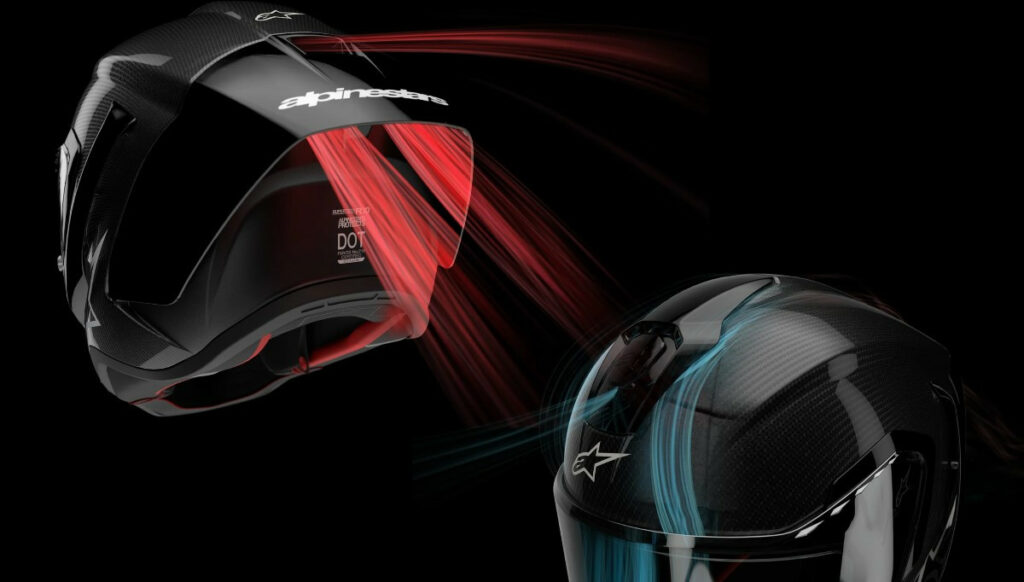
The Top Vent features a large central slider that channels air down to the top of the head for better comfort, which when open, has vents for hot air extraction from the rider’s forehead. Under the rear spoiler, there are two extractor vents for effective hot air exhausting. The Chin Vents are formed by two openings located at the front of the helmet at the sides of the shield lock mechanism, where each flap has a tab in the corner, which is used to open or close the vent. Air entering from this point is channeled towards the inner side of the shields, creating a laminated flow of air that effectively prevents fogging and misting. In addition, the Chin Bar Vents are used to extract humid air to the outside of the helmet.
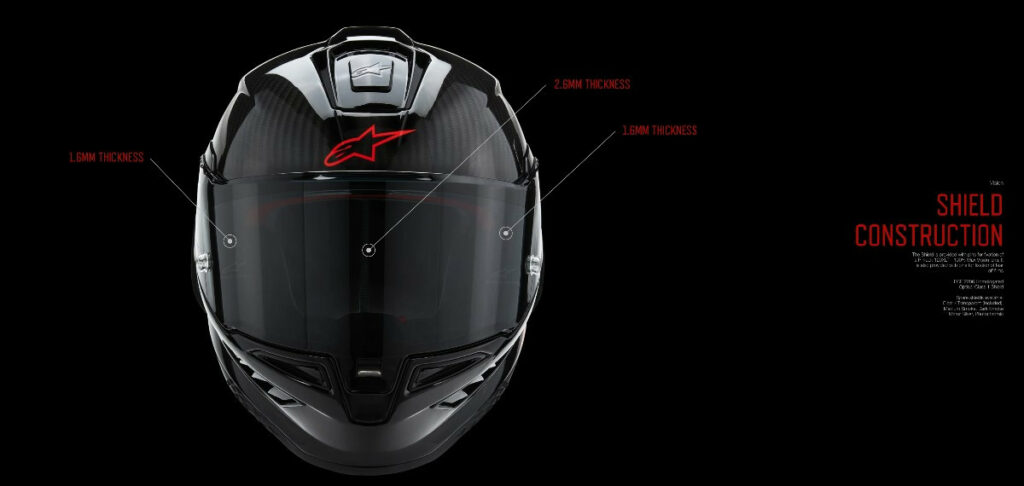
SHIELD FEATURES
THE SHIELD IS DESIGNED FOR MAXIMUM VISION: 220° OF LATERAL VISION AND 57° OF VERTICAL VISION
The shield mechanism is fitted with metal lock levers to to prevent unwanted shield detachment during impacts and/or crashes, which are locked in the closed position by a front metal hook. The cinematic movement is engineered to perfectly seal the visor against the shell’s rubber window trim. The shield is engineered with an impressive wide lowered eyeport on the sides for enhanced peripheral vision, offering 220-degrees of lateral and 57-degrees of vertical visibility and providing a maximized field of view in the riding position and providing great rider comfort.
Additionally, the visor itself can be easily changed or removed thanks to its secure and toolless quick-release system. The S-R10 is fitted with an ECE 22.06 Homologated Optical Class 1 Shield, 3mm in thickness, and coated with an anti-scratch and anti-fog treatment. The shield is equipped with internal pins to accommodate a Pinlock® 120XLT – 100 % MaxVisionTM lens and external pins to accommodate tear-offs.
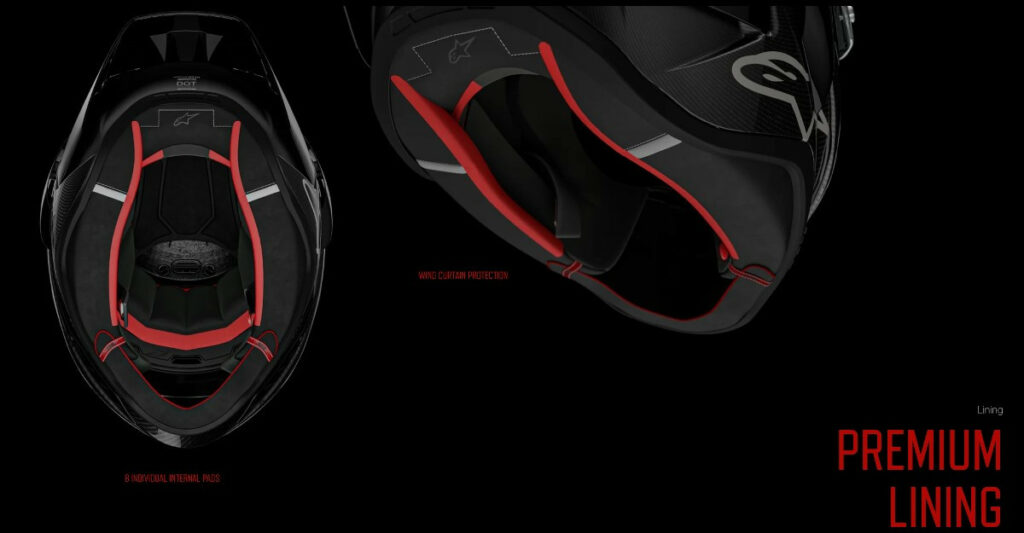
REMOVABLE PREMIUM LINING
REMOVABLE AND WASHABLE, FEATURING FABRICS WITH ANTI-MICROBIAL TREATMENTS
The S-R10 has eight individual internal parts consisting of the crown pad, top pad, cheek pads, chin curtain, chin strap, ear pads, wind deflector, and breath deflector.
Crown Pad: The crown pad and the neck pad are elastically connected, for enhanced oblique impact management and interface with the smooth surface of the inner EPS liner. The crown pad’s construction is based on four panels (front, sides, rear), for an optimized fit with the proper foam thickness.
Top Pad: The top pad is removable and height adjustable via the A-Head Fitment System.
Cheek Pads: The cheek pads are fitted with premium, 3D foam, and fabrics, offering comfort and breathability. The cheek pads feature an ERS emergency extraction system, allowing the side cheek padding to be easily removed by trained medical professionals and they also have a channel for the installation of a hydration hose.
Chin Curtain: A chin curtain is available inside the box to provide further protection against air entering the helmet from below.
Ear Pads: Ear pads are fixed under each cheek pad and help to improve comfort by reducing the aerodynamic noise, they are removable allowing for the installation of a communication system in the helmet.
Wind and Breath Deflectors: The wind and breath deflectors are included to improve aerodynamic behavior and humid air flow, respectively.
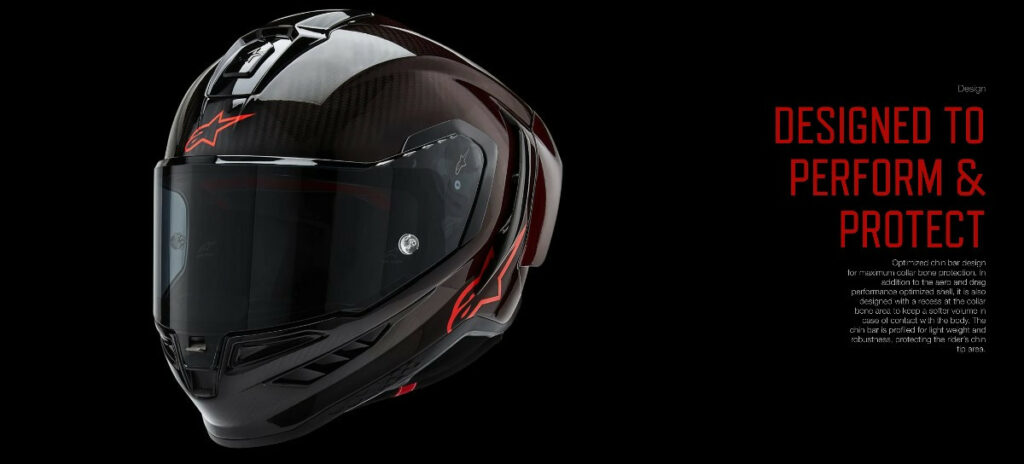
CHIN BAR PROFILE
Another outer shell design protection feature is the chin bar’s profile, where the base area has been specifically sculpted to give a relief section. The bottom profile is raised to clear the collarbone, and instead of the hard carbon shell coming into potential contact with the collarbone, the S-R10 has a softer EPP (expanded Polypropylene) liner which extends beyond the helmet shell itself and is covered by a more flexible rubber compound. This chin bar design provides a reduced chance of any sort of collarbone injury, one of the more common injuries in motorcycling.
WEIGHT
And finally, when it comes to weight, the ECE / DOT / FIM certified Supertech R10 helmet tips the scales at an impressive 1,540 grams for a size medium, or 3.4 pounds, providing the S-R10 with an extremely high performance to protection to weight ratio.
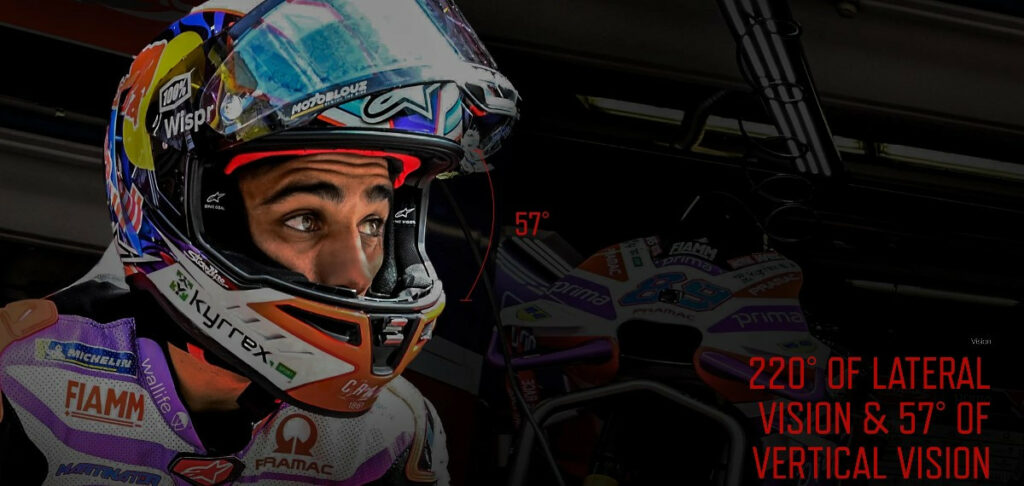
ABOUT ALPINESTARS
Alpinestars was established in 1963 and is the world-leading manufacturer of professional racing products, motorcycling airbag protection, high-performance apparel, and technical footwear. Alpinestars understands that the best design and research are achieved under extreme conditions. The company’s involvement in Formula 1, NASCAR, AMA, World Motocross, and MotoGP has led to the creation of the most advanced technical equipment for the racing world’s top athletes.
ALPINESTARS PROTECTS.
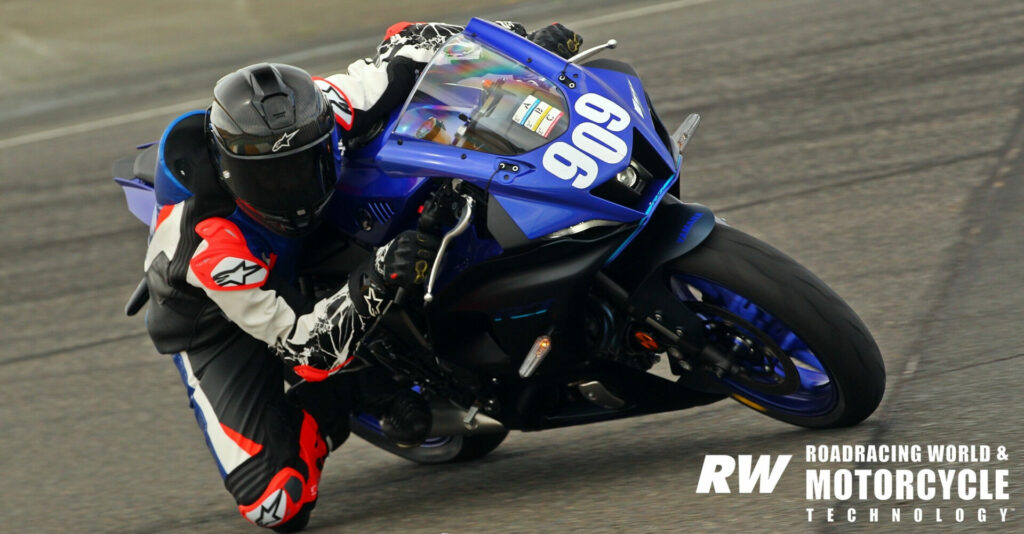
Track-Tested: Alpinestars S-R10 Road Racing Helmet
By Michael Gougis
I came out of the Carousel hard on the gas in second, onto a fairly-quick straight along part of the drag strip. At the end of that straight, a bump kicks the rear of the Yamaha YZF-R1 I’m riding into the air just about the time I’m starting to brake hard from about 125 mph. I was still learning the track at Sonoma Raceway, and as the nose dips and the rear tire starts dancing about, I’m scanning for the pavement imperfections that let me know where to tip the machine into the double-apex right at the end of the straight. The surface is thrashed, so I’m hyper-sensitive to any suggestion of slipping or sliding, and I’ve got my head cranked way to the right, looking beyond the second apex. On top of all of that, I really don’t want to drop this thing–it’s not my bike!
At moments like these, race-specific helmets have advantages that I normally don’t think about. I really didn’t want the helmet moving or slipping on my head, and didn’t want an errant gust of wind causing any difficulties with my eyes or contacts. I did want a wide, clear range of vision and a quiet, stable pocket of air in front of my eyeballs. I was trying to focus, and I didn’t need any distractions.
The Alpinestars Supertech R10 is a racing helmet. It is designed for use at the highest levels of motorsport, period. The helmet you see on Jorge Martin in MotoGP is the same helmet you can buy from Alpinestars. I got a chance to ride in one last summer, during a Z2 Track Days event at Sonoma Raceway, where Alpinestars was introducing its new Racing Absolute V2 leathers and had a couple of the S-R10 helmets available. I rode a 2023 Yamaha YZF-R1 and a Yamaha YZF-R7, provided courtesy of Yamaha.
The helmet is the company’s first foray into road racing headgear, and is loaded with features. It carries ECE 22.06, DOT and FIM certification. The FIM certification is mandatory for any helmet worn by a rider competing in FIM World Championship events. It is primarily based on the old ECE 22.05 standard, but incorporates testing for the helmet’s protection against brain injuries caused by rotational forces. A helmet must first meet either the ECE 22.05, Snell M 2015 or JIS T8133 2015 standards before the FIM will accept it for its own testing.
I pulled on a medium, my normal helmet size, and the fit of the S-R10 was snug and firm, especially at the cheeks. Again, this is exactly what I am looking for in a racing helmet. The fit for my oval-shaped head was precise, with no hot spots and no gaps. Again, exactly what I am looking for. The helmet felt light, and the wide range of vision through the view port was immediately noticeable.
Temperatures were above 90 degrees that day and it was humid, so I opened the vents all the way to get as much airflow through the helmet as I could. I snapped down the visor, which latches securely, and headed out.
My first impression was one of stillness and quiet. Alpinestars says small vortex generators on the upper edge of the face shield lower the amount of noise reaching the rider’s ears. I ride with earplugs to protect what’s left of my hearing, but even with the foam inserts in my ears, the helmet was noticeably on the quiet side.
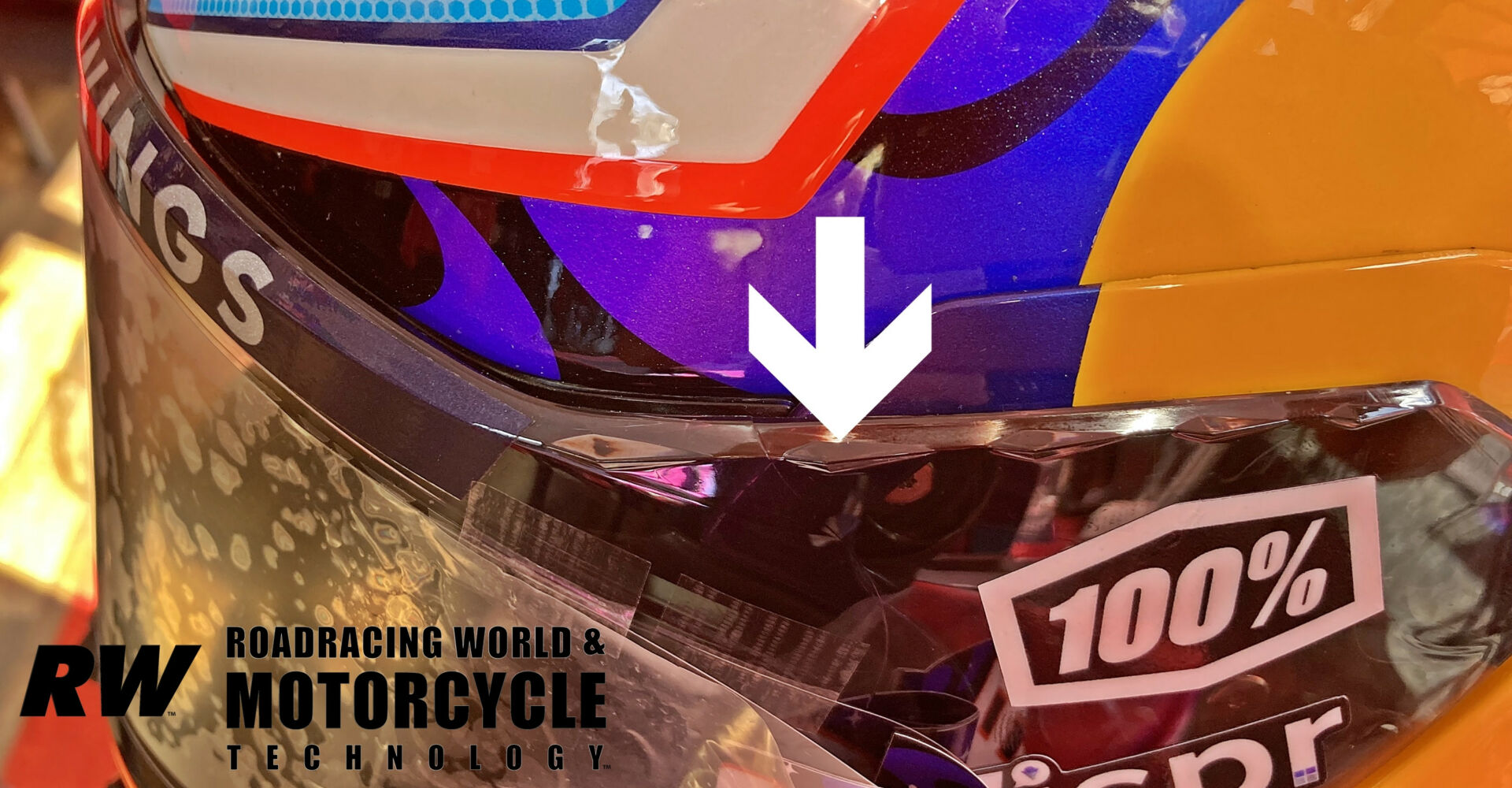
Even with the vents fully open, there was no turbulence behind the face shield. I’ve noticed that a couple of the race-specific helmets I’ve tried lately have flowed less air than more road-oriented helmets. I wonder if that’s not a function of the sheer stupid speed of a modern racebike–Brad Binder took his KTM RC16 to 227.4 mph at Mugello last year, a new MotoGP top speed record. Speeds like that must generate a lot of airflow, which has to be carefully managed. Get it wrong and a rider could have their vision impaired at pretty much the worst possible moment. The S-R10 creates a quiet pocket in front of the eyes while still maintaining adequate airflow over the scalp.
I noticed no real aerodynamic lift, although speeds at Sonoma aren’t what they are at other, faster tracks. I did notice that the visor was easy to unlock heading back to the pits. And the shield can be changed in a matter of seconds.
The highest compliment I can give to safety equipment, other than saying that it works, is to say that once it was in place, I never noticed it. It was funny, because I was wearing an older mid-range brand of boot that day, and I did notice that it was starting to chafe the top of my right foot and was allowing air down the back of my right heel (and yes, those thoughts were that specific even mid-corner at Sonoma. When something is not right at speed, it’s amazing how the brain pays immediate attention to an issue!)
Once I clicked the visor into place on the S-R10, I never thought about it again until I pulled it off when I was back in the garage.
I would not hesitate to race in this helmet, and I look forward to hitting the track in another one in the future.
Technical Features
A detailed breakdown of the Alpinestars S-R10 has been published here on roadracingworld.com, but a brief overview of some of the main features starts with the shell. A multi-layer composite of carbon fiber, aramid, and fiberglass layers, the shell is designed to provide rigidity while also controlling deflection for reducing the transmission of impact energy, the company says. The inner expanded polystyrene liner has eight sections and six different densities to manage energy absorption.
The helmet comes with two spoilers–standard and long–and both are designed to break away during an impact.
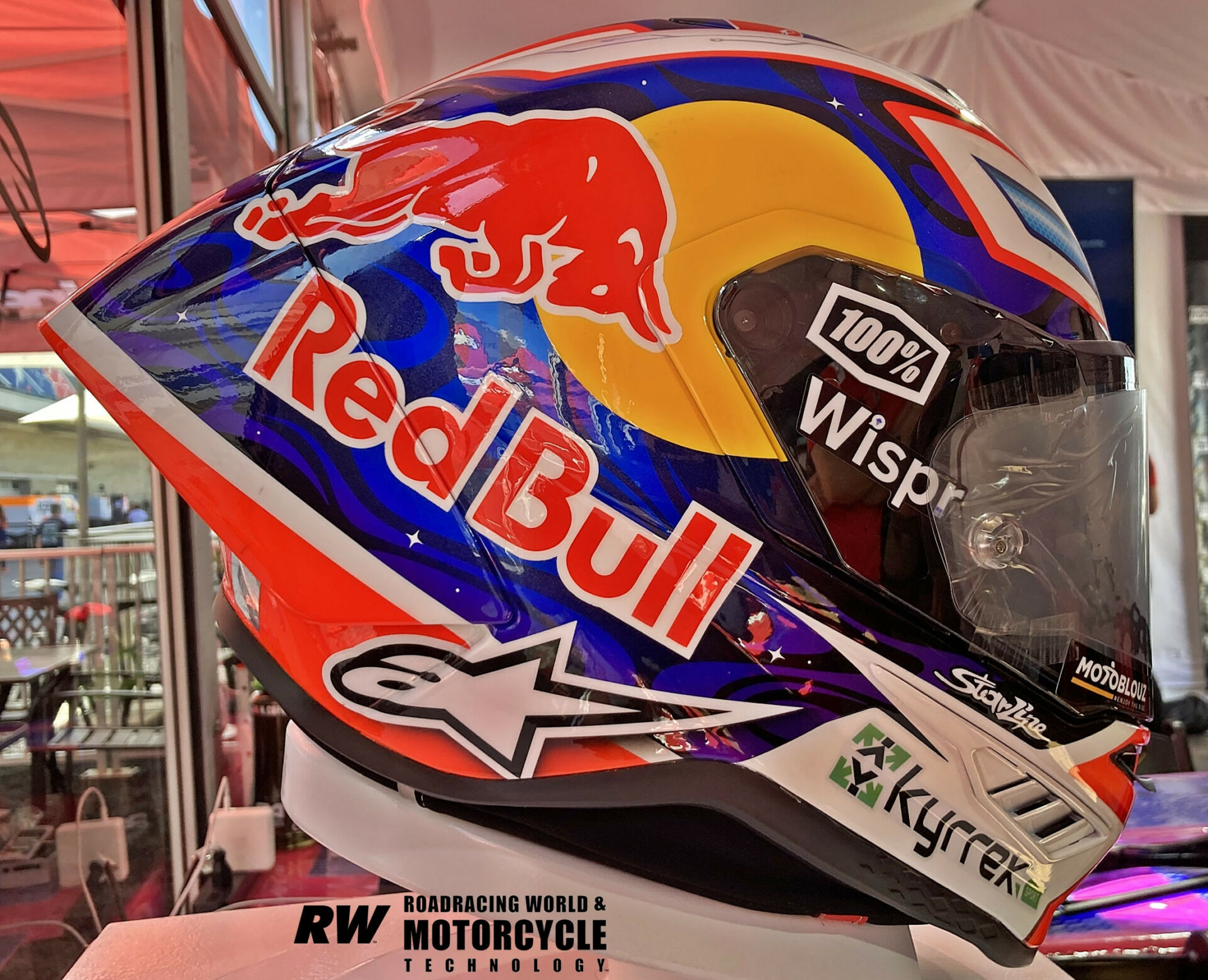
The A-Head system allows the rider to tailor how deeply into the helmet their head sits, as well as angle the helmet forward or backward onto the rider’s head. Padded cutouts in the lower ridge of the shell reduce the risk of the helmet being forced into the collarbone in a crash. The faceshield locking mechanisms are metal to help prevent it from flying off in an impact. The helmet is equipped with an emergency release system. The medium-size helmet weighs 1540 grams (3.4 pounds), the company says.


